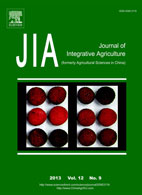|
|
Postulation of Leaf Rust Resistance Genes in Seven Chinese Spring Wheat Cultivars
SHI Li-hong, ZHANG Na, HU Ya-ya, WEI Xue-jun, YANG Wen-xiang , LIU Da-qun
2013, 12(9):
1580-1588.
DOI: 10.1016/S2095-3119(13)60566-3
To detect the leaf rust resistance genes in the 7 Chinese spring wheat clultivars Shenmian 99025, Shenmia 99042, Shenmian 85, Shenmian 91, Shenmian 96, Shenmian 1167 and Shenmian 962, Thatcher, Thatcher backgrounded near-isogenic lines and 15 pathotypes of P. triticina were used for gene postulate at the seedling stage, and 9 of the 15 pathotypes were used in the field tests. Molecular markers closely linked to, or co-segregated with resistance genes Lr1, Lr9, Lr10, Lr19, Lr20, Lr21, Lr24, Lr26, Lr28, Lr29, Lr32, Lr34, Lr35, Lr37, Lr38, and Lr47 were screened to assist detection of the resistance genes. As results, 4 known resistance genes, including Lr1, Lr9, Lr26, and Lr34, and other unknown resistance genes were postulated singly or in combination in the tested cultivars. Shenmian 85, Shenmian 91, Shenmian 96, Shenmian 962, Shenmian 1167, and Shenmian 99042 are potentially useful for wheat production and breeding programs. The result suggested that combining gene postulation, molecular markers and pedigrees is effective and more accuracy method to know the resistance genes in cultivars.
|
